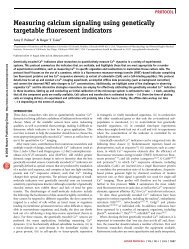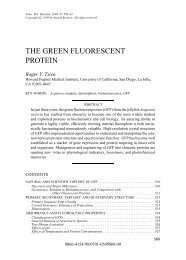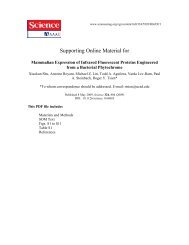Autofluorescent Proteins with Excitation in the Optical ... - Tsien
Autofluorescent Proteins with Excitation in the Optical ... - Tsien
Autofluorescent Proteins with Excitation in the Optical ... - Tsien
Create successful ePaper yourself
Turn your PDF publications into a flip-book with our unique Google optimized e-Paper software.
Animal Imag<strong>in</strong>g<br />
Transcription units conta<strong>in</strong><strong>in</strong>g mKate, dNeptune, or IFP1.1 followed by <strong>the</strong><br />
poliovirus IRES and a GFP cod<strong>in</strong>g sequence were constructed <strong>in</strong> pENTR1<br />
by standard methods, and <strong>the</strong>n recomb<strong>in</strong>ed <strong>in</strong>to pAd-CMV-DEST by <strong>the</strong><br />
Gateway system (Invitrogen). L<strong>in</strong>earized plasmid was used to transfect<br />
HEK293A cells for adenovirus production, followed by amplification and purification<br />
on FastTrap columns (Millipore) and elution <strong>in</strong>to HBSS + 10% glycerol.<br />
Serial dilutions onto HEK293A cells and GFP visualization were performed to<br />
assess titers. Injections, imag<strong>in</strong>g, and dissection were carried out <strong>in</strong> duplicate.<br />
Mice were anes<strong>the</strong>sized <strong>with</strong> ketam<strong>in</strong>e/xylaz<strong>in</strong>e, and <strong>the</strong>n <strong>in</strong>jected via <strong>the</strong> tail<br />
ve<strong>in</strong> <strong>with</strong> 50 mlof53 10 10 <strong>in</strong>fectious units per milliliter of purified adenoviruses.<br />
Five days later, mice were shaved on <strong>the</strong>ir ventral side and anes<strong>the</strong>sized <strong>with</strong><br />
ketam<strong>in</strong>e/xylaz<strong>in</strong>e. Images were acquired on a Maestro 1 animal fluorescence<br />
imag<strong>in</strong>g system (CRI) <strong>with</strong> <strong>in</strong>dicated excitation filters and a tunable liquid<br />
crystal emission filter of 40 nm bandwidth centered on <strong>the</strong> <strong>in</strong>dicated wavelengths.<br />
For quantification, off-animal dark counts were first subtracted, and<br />
<strong>the</strong>n mid-sagittal l<strong>in</strong>e <strong>in</strong>tensities were obta<strong>in</strong>ed <strong>in</strong> ImageJ <strong>with</strong> <strong>the</strong> Plot Profile<br />
function. Similar results were obta<strong>in</strong>ed <strong>in</strong> <strong>the</strong> duplicate samples for each condition.<br />
For <strong>the</strong> charts <strong>in</strong> Figure 3, l<strong>in</strong>e <strong>in</strong>tensities from duplicate conditions were<br />
averaged and background was def<strong>in</strong>ed as <strong>the</strong> mean mid-sagittal <strong>in</strong>tensity of<br />
un<strong>in</strong>fected liver, treatment-matched <strong>in</strong> terms of pre- or post-dissection condition.<br />
Def<strong>in</strong><strong>in</strong>g background as <strong>the</strong> mid-thoracic region of <strong>in</strong>fected animals gave<br />
similar results. For confocal imag<strong>in</strong>g, three randomly oriented freshly prepared<br />
liver slices were placed on a coverslip and imaged <strong>with</strong> a 403 water objective<br />
on a Zeiss LSM 5Live microscope. For each slice, fluorescence <strong>in</strong>tensities<br />
were measured from maximum <strong>in</strong>tensity projections of a ten section stack of<br />
total thickness of 40 mm. All animal procedures were performed accord<strong>in</strong>g<br />
to protocols approved by <strong>the</strong> University of California, San Diego, <strong>in</strong>stitutional<br />
animal care and use committee. For spectral unmix<strong>in</strong>g, <strong>the</strong> predicted Neptune<br />
distribution <strong>in</strong> <strong>the</strong> <strong>in</strong>frared image is removed based on <strong>the</strong> Neptune distribution<br />
<strong>in</strong> <strong>the</strong> far-red channel and <strong>the</strong> relative efficiencies <strong>in</strong> <strong>the</strong> two channels <strong>in</strong> detect<strong>in</strong>g<br />
Neptune, as calculated from <strong>the</strong> Neptune spectra.<br />
Crystallization and Ref<strong>in</strong>ement<br />
For crystallization, <strong>the</strong> His tag on <strong>the</strong> prote<strong>in</strong> was removed by TEV protease<br />
digestion. Crystals were grown by <strong>the</strong> sitt<strong>in</strong>g drop vapor diffusion method.<br />
One microliter of prote<strong>in</strong> at 10 mg/ml was mixed <strong>with</strong> 1 ml of 0.1 M HEPES<br />
(pH 7.0), 0.2 M CaCl2, and 20% PEG 6000 at 18 C. Crystals were cryoprotected<br />
<strong>with</strong> a mixture of 66.5% Paratone-N, 28.5% paraff<strong>in</strong> oil, and 5% glycerol<br />
(Sugahara and Kunishima, 2006) prior to immersion <strong>in</strong> liquid nitrogen.<br />
Data were collected at Beaml<strong>in</strong>e 8.3.1 at <strong>the</strong> Advanced Light Source, Lawrence<br />
Berkeley National Laboratory and processed <strong>with</strong> ELVES (Holton and<br />
Alber, 2004) and MOSFLM/SCALA (Evans, 2006; Leslie, 2006). The crystal<br />
structure was solved by molecular replacement us<strong>in</strong>g PHASER (McCoy<br />
et al., 2007) <strong>with</strong> mKate at pH 4.2 <strong>with</strong>out <strong>the</strong> chromophore (PDB 3BXA) as<br />
<strong>the</strong> search model. The structure was ref<strong>in</strong>ed <strong>with</strong> TLS parameters us<strong>in</strong>g<br />
PHENIX (Zwart et al., 2008), alternat<strong>in</strong>g <strong>with</strong> manual revision of <strong>the</strong> model<br />
us<strong>in</strong>g COOT (Emsley and Cowtan, 2004). No planarity restra<strong>in</strong>ts were applied<br />
to <strong>the</strong> chromophore dur<strong>in</strong>g ref<strong>in</strong>ement. Crystallographic data and ref<strong>in</strong>ement<br />
statistics are presented <strong>in</strong> Table 3. Structure validation was performed <strong>with</strong><br />
WHAT_CHECK (Hooft et al., 1996). Neptune and mKate (pH 7.0) (PDB file<br />
3BXB) were aligned and root mean square deviations were calculated us<strong>in</strong>g<br />
<strong>the</strong> align command <strong>in</strong> PyMol (http://www.pymol.org).<br />
ACCESSION NUMBERS<br />
Coord<strong>in</strong>ates have been deposited <strong>in</strong> <strong>the</strong> PDB <strong>with</strong> accession codes 3IP2.<br />
Sequences have been deposited <strong>in</strong> <strong>the</strong> EMBL Nucleotide Sequence Database<br />
<strong>with</strong> accession codes FN565568 (Neptune) and FN565569 (mNeptune), and<br />
<strong>in</strong> GenBank <strong>with</strong> accession codes GU189532 (Neptune) and GU189533<br />
(mNeptune).<br />
SUPPLEMENTAL DATA<br />
Supplemental Data <strong>in</strong>clude Supplemental Experimental Procedures, six<br />
figures, and four tables and can be found <strong>with</strong> this article onl<strong>in</strong>e at http://<br />
www.cell.com/chemistry-biology/supplemental/S1074-5521(09)00360-3.<br />
ACKNOWLEDGMENTS<br />
We thank Paul Ste<strong>in</strong>bach for assist<strong>in</strong>g <strong>with</strong> prote<strong>in</strong> photobleach<strong>in</strong>g and related<br />
analysis. We acknowledge <strong>the</strong> follow<strong>in</strong>g sources of support: <strong>the</strong> Jane Coff<strong>in</strong><br />
Childs Foundation and a Burroughs Wellcome Career Award for Medical<br />
Scientists (M.Z.L.), <strong>the</strong> University of California, San Diego, Chancellor’s Award<br />
for Undergraduate Research (M.R.M.), a Howard Hughes Medical Institute<br />
(HHMI) predoctoral fellowship (N.C.S.), a Canadian Institutes of Health<br />
Research postdoctoral fellowship (R.E.C.), <strong>the</strong> National Institutes of Health<br />
(NIH) Medical Scientist Tra<strong>in</strong><strong>in</strong>g Program and U.S. Army Breast Cancer<br />
Research Program (BCRP) grant W81XWH-05-01-0183 (T.A.A.), NIH grant<br />
R01 GM048958 (H-L.N., W.M., and T.A.), HHMI, NIH grants R01 GM086197<br />
and R37 NS027177, and BCRP grant W81XWH-05-01-0183 (R.Y.T.).<br />
Received: June 29, 2009<br />
Revised: October 5, 2009<br />
Accepted: October 12, 2009<br />
Published: November 24, 2009<br />
REFERENCES<br />
1178 Chemistry & Biology 16, 1169–1179, November 25, 2009 ª2009 Elsevier Ltd All rights reserved<br />
Chemistry & Biology<br />
Fluorescent <strong>Prote<strong>in</strong>s</strong> <strong>with</strong> Far-Red <strong>Excitation</strong><br />
Abbyad, P., Childs, W., Shi, X., and Boxer, S.G. (2007). Dynamic Stokes<br />
shift <strong>in</strong> green fluorescent prote<strong>in</strong> variants. Proc. Natl. Acad. Sci. USA 104,<br />
20189–20194.<br />
Baird, G.S., Zacharias, D.A., and <strong>Tsien</strong>, R.Y. (2000). Biochemistry, mutagenesis,<br />
and oligomerization of DsRed, a red fluorescent prote<strong>in</strong> from coral.<br />
Proc. Natl. Acad. Sci. USA 97, 11984–11989.<br />
Chalfie, M., and Ka<strong>in</strong>, S.R. (2006). Green Fluorescent Prote<strong>in</strong>: Properties,<br />
Applications, and Protocols (Hoboken, NJ: Wiley-Interscience).<br />
Col<strong>in</strong>, M., Moritz, S., Schneider, H., Capeau, J., Coutelle, C., and Brahimi-<br />
Horn, M.C. (2000). Haemoglob<strong>in</strong> <strong>in</strong>terferes <strong>with</strong> <strong>the</strong> ex vivo luciferase lum<strong>in</strong>escence<br />
assay: consequence for detection of luciferase reporter gene expression<br />
<strong>in</strong> vivo. Gene Ther. 7, 1333–1336.<br />
Emsley, P., and Cowtan, K. (2004). Coot: model-build<strong>in</strong>g tools for molecular<br />
graphics. Acta Crystallogr. D Biol. Crystallogr. 60, 2126–2132.<br />
Evans, P. (2006). Scal<strong>in</strong>g and assessment of data quality. Acta Crystallogr. D<br />
Biol. Crystallogr. 62, 72–82.<br />
Gross, L.A., Baird, G.S., Hoffman, R.C., Baldridge, K.K., and <strong>Tsien</strong>, R.Y.<br />
(2000). The structure of <strong>the</strong> chromophore <strong>with</strong><strong>in</strong> DsRed, a red fluorescent<br />
prote<strong>in</strong> from coral. Proc. Natl. Acad. Sci. USA 97, 11990–11995.<br />
Henderson, J.N., Ai, H.W., Campbell, R.E., and Rem<strong>in</strong>gton, S.J. (2007). Structural<br />
basis for reversible photobleach<strong>in</strong>g of a green fluorescent prote<strong>in</strong> homologue.<br />
Proc. Natl. Acad. Sci. USA 104, 6672–6677.<br />
Holton, J., and Alber, T. (2004). Automated prote<strong>in</strong> crystal structure determ<strong>in</strong>ation<br />
us<strong>in</strong>g ELVES. Proc. Natl. Acad. Sci. USA 101, 1537–1542.<br />
Hooft, R.W., Vriend, G., Sander, C., and Abola, E.E. (1996). Errors <strong>in</strong> prote<strong>in</strong><br />
structures. Nature 381, 272.<br />
Lakowicz, J.R. (2006). Pr<strong>in</strong>ciples of Fluorescence Spectroscopy (New York:<br />
Spr<strong>in</strong>ger).<br />
Leslie, A.G. (2006). The <strong>in</strong>tegration of macromolecular diffraction data. Acta<br />
Crystallogr. D Biol. Crystallogr. 62, 48–57.<br />
Li, H., Robertson, A.D., and Jensen, J.H. (2005). Very fast empirical prediction<br />
and rationalization of prote<strong>in</strong> pKa values. <strong>Prote<strong>in</strong>s</strong> 61, 704–721.<br />
McCoy, A.J., Grosse-Kunstleve, R.W., Adams, P.D., W<strong>in</strong>n, M.D., Storoni, L.C.,<br />
and Read, R.J. (2007). Phaser crystallographic software. J. Appl. Crystallogr.<br />
40, 658–674.<br />
Ntziachristos, V. (2006). Fluorescence molecular imag<strong>in</strong>g. Annu. Rev. Biomed.<br />
Eng. 8, 1–33.<br />
Ormo, M., Cubitt, A.B., Kallio, K., Gross, L.A., <strong>Tsien</strong>, R.Y., and Rem<strong>in</strong>gton, S.J.<br />
(1996). Crystal structure of <strong>the</strong> Aequorea victoria green fluorescent prote<strong>in</strong>.<br />
Science 273, 1392–1395.<br />
Petersen, J., Wilmann, P.G., Beddoe, T., Oakley, A.J., Devenish, R.J., Prescott,<br />
M., and Rossjohn, J. (2003). The 2.0-A crystal structure of eqFP611,






